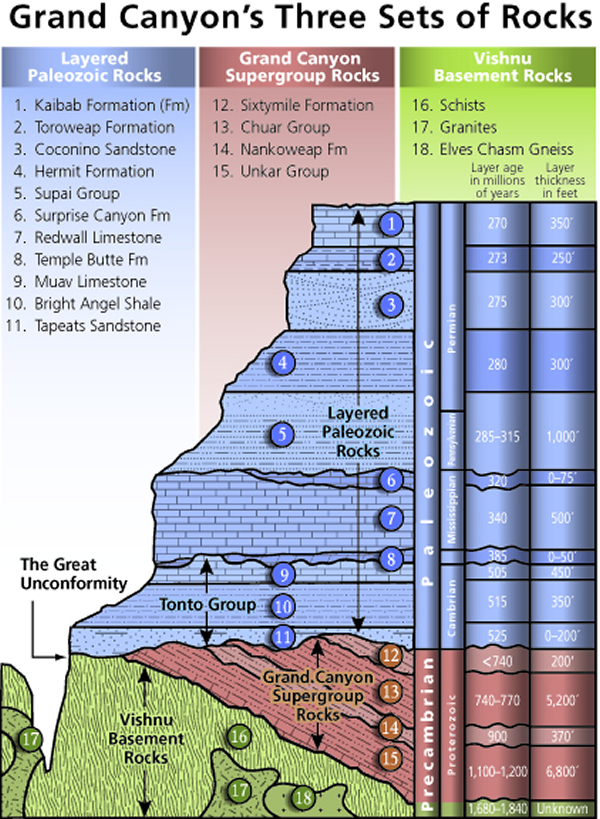
We can’t see the Colorado River cutting through the Colorado Plateau as it happened, we can see the evidence in the rock records of the Grand Canyon.
Rocks, after all, even cometary ones, record a lot of history.
What do we do when we are literally missing some of that history? Well, if you’re a geologist, you try to solve the why of the missing rock. And in the Grand Canyon, there are areas where more than a billion years’ worth of rock is missing. Of course, we know erosion is a factor, but a billion years is a very long time, even geologically speaking, and we want to know what caused all that rock to disappear.
Let me lay this out for you all, so to speak. The basement rocks of the Grand Canyon, the rocks that are the oldest and sit at the bottom, are between 1.4 and 1.8 billion years old. However, at the western end near Lake Mead, the rocks sitting right on top of that basement rock are only 520 million years old. That’s a significant chunk of the geological record missing.
This section of missing rock is called the Great Unconformity, and it exists not just in the Grand Canyon but also in other locations of North America. That makes it even more important to understand. And now a team from the University of Colorado Boulder has published a paper in the journal Geology that provides a theory for what happened to make all that rock disappear.
Per the press release: The team reports that a series of small yet violent faulting events may have rocked the region during the breakup of an ancient supercontinent called Rodinia. The resulting havoc likely tore up the earth around the canyon, causing rocks and sediment to wash away and into the ocean.

The method the team used is called “thermochronology,” and it’s used to track the record of heat in rock. When rock formations are buried, the pressure on top causes them to heat up. In some instances, the intense heat and pressure can cause deformations of the rock, and those deformations can change the chemistry of the minerals.
And what they found was that the temperature changes were all over the place in different parts of the Canyon. The western basement rock rose to the surface about 700 million years ago, while the eastern half was buried under kilometers of sediment. That’s where the breakup of Rodinia comes in. As that supercontinent began to pull apart, it caused major upheavals and possibly uplifted different portions of the Grand Canyon at different times. This uplifting may have caused overlying rocks to crumble and fall down into the Colorado River, wiping them out of the geologic record altogether.
In exploring the Grand Canyon, Barra Peak, graduate student and lead author of the new study, notes: There are beautiful lines. At the bottom, you can see very clearly that there are rocks that have been pushed together. Their layers are vertical. Then there’s a cutoff, and above that, you have these beautiful horizontal layers that form the buttes and peaks that you associate with the Grand Canyon.
The research team now intends to expand their research to other sites of the Great Unconformity and continue piecing together the disappearance of the rocks.
More Information
CU Boulder press release
“Zircon (U-Th)/He thermochronology reveals pre-Great Unconformity paleotopography in the Grand Canyon region, USA,” B.A. Peak, R.M. Flowers, F.A. Macdonald, and J.M. Cottle, 2021 August 12, Geology




 Join the Crew!
Join the Crew!
 Escape Velocity Space News
Escape Velocity Space News
0 Comments